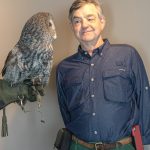Our species is not alone in moving around, thriving in many climates. In our global conquest we’ve been followed by bed bugs, rats, rock pigeons, and many plants and animals using changes we make. The Eurasian collared dove was transplanted to the Bahamas from Europe which it had invaded from South Asia. From the Bahamas, it was a short flight to Florida. From whence collared doves spread across continental U.S. All in a few decades, far faster than it took our species to spread across the Americas millennia ago.
Most of us would describe parrots as either pets or tropical birds. The only native species of parrot in North America was the Carolina parrakeet. It inhabited the dense forests east of the Mississippi River. Once abundant, this parrot was driven to extinction around 1920. But parrots like the trees and gardens we plant. At least twenty species of parrot are now believed to nest in Florida. At least fourteen species are now breeding in Europe. I have seen rose-ringed parakeets in London and Amsterdam, far from anything tropical. Parrots are fine performers so at least 30 species now live in Hollywood and its Los Angeles suburb.
In San Francisco the red-masked parakeet has become popular and successful without once needing a laptop or email. Natives of Ecuador and Peru, they survive in forest, suburban and even semi-arid habitat. When somebody released a group in San Francisco, those birds must have looked around, shrugged feathered shoulders, and thought, “We can do this.” And they did.
Just over a foot tall (half of that tail), these birds are social, smart, adept communicators and understand our species. It is not known how and when these birds arrived in San Francisco, some time in the 1980s or later. Theories abound—pet shop escapees, deliberately released because of some import violation, etc. By 2000 these parrots were living on Telegraph Hill and there mentored a man who became their friend, their food source, their champion, their mascot.
Twenty years ago a documentary, “The Wild Parrots of Telegraph Hill,” was released. It showed Mark Bittner, his feathered neighbors, and their close relationship. Back when the documentary was made there were about 50 parrots on Telegraph Hill. Reports on the birds’ winter roost indicate there are over 200 now.
This documentary has been technically refreshed and re-released. Salem Cinema is going to show it on May 19 at 6:30 p.m. If you are interested, get your tickets in advance. It’s likely to sell out.
I am familiar with the Telegraph Hill birds, having lived near them, met them. Salem Audubon Society President Tim Johnson and I will be at the documentary showing, and answer questions afterward. Proceeds from this showing will go to support Salem Audubon Society which is involved in numerous educational and environmental programs as well as maintaining the Audubon Preserve in West Salem.
See more about the film here: https://www.salemcinema.com/movie/the-wild-parrots-of-telegraph-hill-2
For information about upcoming Salem Audubon programs and activities, see www.salemaudubon.org, or Salem Audubon’s Facebook page.
Harry Fuller is an Oregon birder and natural history author of “Freeway Birding” and the newly-published “Birding Harney County.” He is a member of the Salem Audubon Society. Contact him at [email protected] or atowhee.blog. His “Some Fascinating Things About Birds” column appears regularly in Salem Reporter.
SUPPORT OUR WORK – We depend on subscribers for resources to report on Salem with care and depth, fairness and accuracy. Subscribe today to get our daily newsletters and more. Click I want to subscribe!

Harry Fuller is an Oregon birder and natural history author of three books: “Freeway Birding,” "Great Gray Owls of California, Oregon and Washington," and "San Francisco's Natural History--Sand Dunes to Streetcars." He leads birding trips for the Malheur Field Station. He is a member of the Salem Audubon Society, and leads bird trips locally. Harry has just published a new book, BIrding Harney County.









